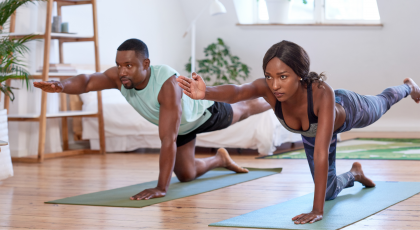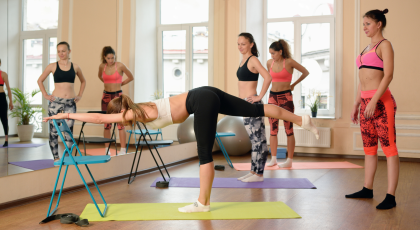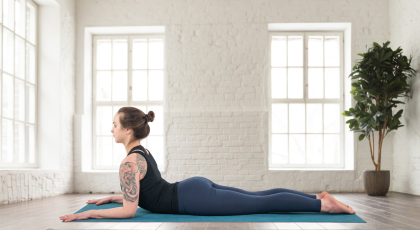View basket (0 items $0.00)

Prenatal Yoga for the Pelvic Floor
In many ways, pregnancy is an athletic endeavor. For nine months, we train our bodies for the big day: delivering a human into the world. As with any physical challenge, injuries may occur, and often, the pelvic floor is the group of muscles that can take the greatest hit. This article explores ways to strengthen the pelvic floor and the muscles that support it to prepare the pelvic floor for childbirth and beyond.
What is the Pelvic Floor?
The pelvic floor is a group of muscles that are often overlooked until pregnancy. This sling-shaped muscle group covers the bottom of the lower pelvis and is composed of two layers: the perineum and the pelvic diaphragm. Together, these muscle groups support the weight of the lower abdomen and serve as a gateway from the vagina, urethra, and anus to the external world.
After nine months of bearing the weight of a growing baby and a few momentous hours (or days) of labor and delivery, it’s unsurprising that pelvic floor soreness is common after childbirth. Pain from tearing, urinary incontinence, or pelvic organ prolapse can also occur in the two months following childbirth.
The good news is that training the pelvic floor prenatally may prevent injury and promote healing. For example, one systematic review of 24 studies found prenatal exercise, including pelvic floor muscle training, reduced the odds and symptom severity of both prenatal and postnatal urinary incontinence (1).
How to Strengthen the Pelvic Floor with Yoga
Prenatal yoga can provide an opportunity to strengthen both the pelvic floor and the muscle groups that support it, including the deep hip muscles, adductor muscles, gluteal muscles, lower abdominal muscles. The following simple prenatal practices can provide a starting point. For further reading, Blandine Calais-Germain’s book The Female Pelvis: Anatomy and Exercises (2) provides a more detailed and complete overview of prenatal pelvic floor exercises.
Before beginning pelvic floor exercises, it can be invaluable for all expecting birthing people to consult with a pelvic floor physical therapist. If the pelvic floor muscles are hypertonic or chronically tight, practicing pelvic floor exercises may do more harm than good. If you currently experience urinary or fecal incontinence, pelvic organ prolapse, pelvic floor pain, chronic low back pain, or pain during sex, first consult a pelvic floor physical therapist, who can provide tailored exercises. Additionally, anytime you begin a new form of exercise prenatally, it’s a good idea to check in with your physician.
Yogic Breathing for Pelvic Floor Strengthening

-
Pelvic floor strengthening exercises can be practiced in virtually any position. To isolate engagement to the pelvic floor rather than rely on supporting muscles, you may try practicing pelvic floor strengthening in postures that take supporting muscles out of the equation, such as supported Yogic Squatting Pose (Malasana). To practice supported Malasana, take a seat on two blocks stacked on their lowest height. If this causes any discomfort in the ankles, knees, or hips; if you have placenta previa; or if you’re in the third trimester and your baby is in a breech position, opt instead to take these exercises in a comfortable seated position such as Easy Sitting Pose (Sukhasana) (above) or Supported Hero’s Pose (Virasana).
-
Begin by visualizing the pelvic floor. Locate your breath and imagine the sling-shaped musculature of the pelvic diaphragm softening as you inhale and hugging upward and inward as you exhale. Without contracting these muscles yet, continue imagining this movement for about 10 breaths.
-
Next, begin to add subtle movement to your breath. As you exhale, contract the pelvic floor upward and inward as if lifting a tissue up from its center. As you inhale, relax the muscles of the pelvic floor, visualizing the pelvic floor muscles softening downward and outward. Continue this movement for another 10 rounds of breath.
-
As you become comfortable with this exercise, you can begin to vary it. For example, you can play with adding long and quick pelvic floor contractions, localizing the contraction to specific areas of the pelvic floor, or vocalizing as you contract the pelvic floor. With any variation, make sure to fully rest the pelvic floor muscles for at least as long as each engagement.
Yoga Practices to Strengthen Muscles that Support the Pelvic Floor
Diaphragmatic Breathing

Strong abdominal muscles are key to supporting the pelvic floor, and the transverse abdominus, the deepest core muscles, are also key to the pushing phase of childbirth. And yet, practicing core work that is too strenuous may worsen diastasis recti (separation of the abdominal muscles that naturally occurs during pregnancy). Instead, simple, gentle abdominal exercises such as diaphragmatic breathing can tone the transverse abdominus.
-
To practice diaphragmatic breathing, stay in your comfortable seat, and place your palms on your belly, spreading your fingers around the navel and lower ribs.
-
Let your belly, low back, and ribcage gently inflate with air as you breathe in, and without forcing, let them soften inward in as you exhale.
-
Once you feel comfortable with this diaphragmatic style of breathing, you can begin to vocalize as you breathe out. Trying exhaling with “Shh,” “Hhh,” or “Sss,” sounds, and notice how this shifts sensation in the abdominal region.
Utkatasana (Chair Pose) with a Yoga Block

The adductors are the muscles of the inner thighs that often contract in coordination with the pelvic floor. Practicing Chair Pose while holding a block between the inner thighs can strengthen the adductors and can help you to distinguish engagement of the adductors from the engagement of the pelvic floor muscles. (Variation with a block above and a wider stance pictured below)
-
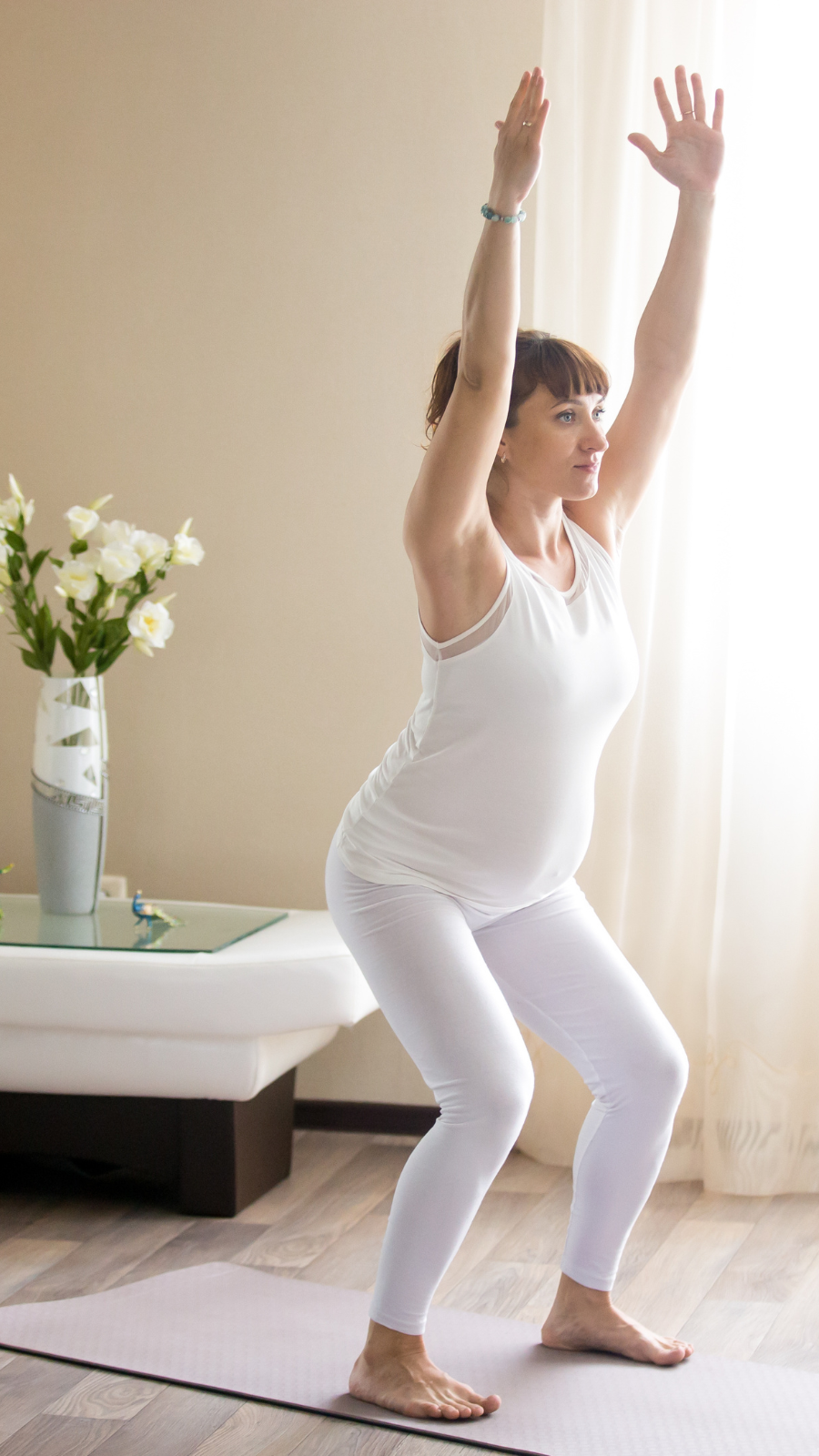 Slowly and mindfully come to standing with your feet slightly wider than hip-width apart. Set a yoga block, a thick book, or a rolled-up blanket between your thighs.
Slowly and mindfully come to standing with your feet slightly wider than hip-width apart. Set a yoga block, a thick book, or a rolled-up blanket between your thighs. -
Reach your arms overhead and either keep your arms extended with your palms facing toward one another or bend your elbows, creating a goal post shape with your arms.
-
To come into Chair Pose, bend your knees, keeping your knees pointing in the same direction as your toes. Allow your pelvis to tilt forward and point your tailbone back.
-
Gently squeeze inward on the block on an exhalation to engage the adductor muscles. As you inhale, stay in Chair Pose but soften the engagement of your inner thighs. As you exhale, squeeze the block inward again. Repeat this engagement for 5-10 rounds of breath.
Tabletop Pose (Bharmanasana) Heel Presses
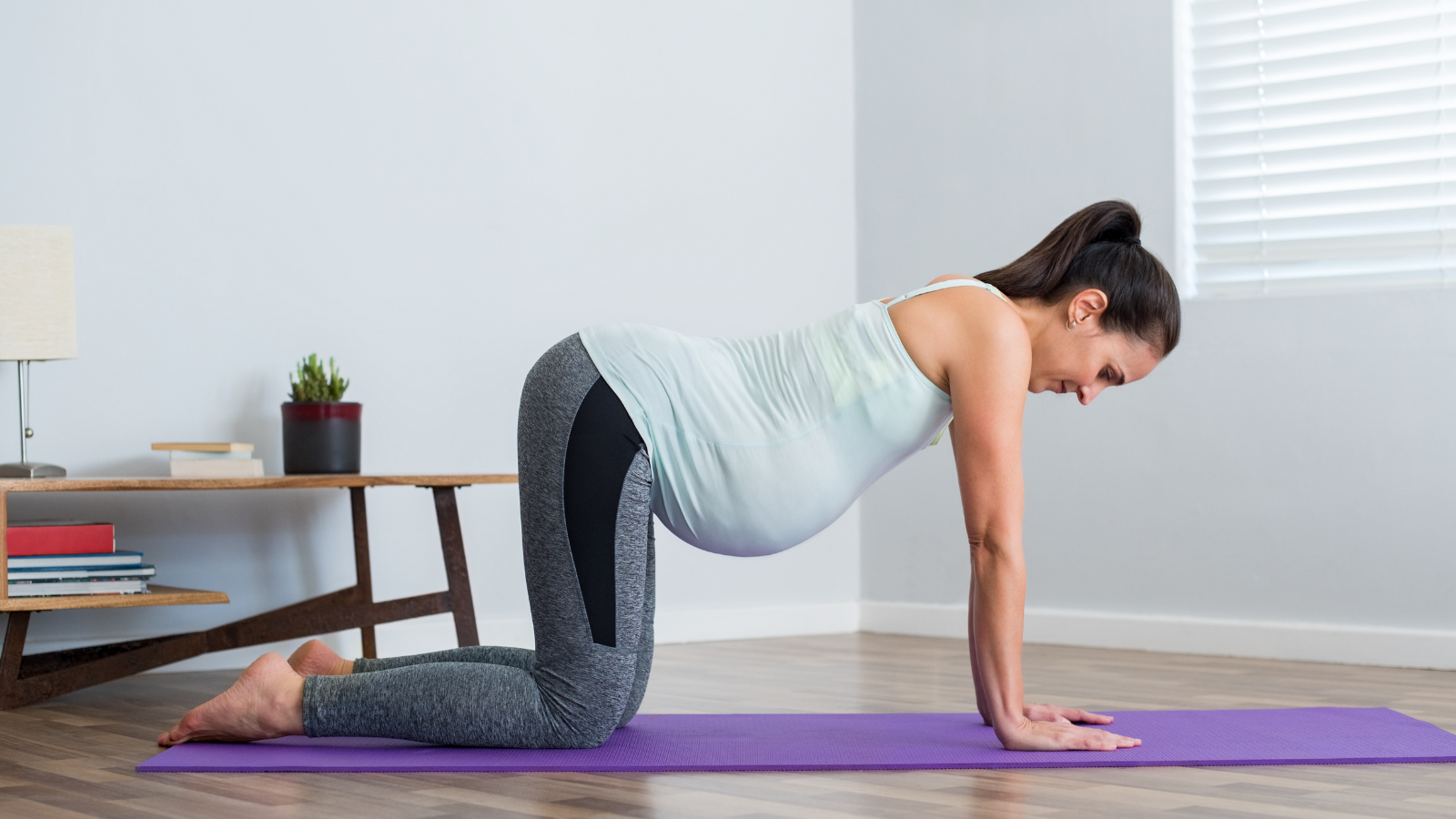
The hormone relaxin can make the pelvic joints more flexible, or even too flexible, during pregnancy. Strengthening the glutes can support the pelvic joints in addition to supporting the pelvic floor.
-
Slowly make your way down to Tabletop Pose on all fours with your hands and knees grounded on the mat. Your wrists should line up under your shoulders and your knees should line up under your hips. If Tabletop Pose causes discomfort in your wrists, lower your elbows down to the mat.
-
Lift your left knee to the same line as your left hip with your left calf and thigh bent at a 90-degree angle.
-
Keep your left foot flexed, and as you exhale, engage your left glute as you press your left heel an inch upward toward the ceiling. As you inhale, soften the engagement.
-
Repeat this movement 5-10 times before repeating on the second side.
 Lacey Gibson Ramirez is a Boston-based ERYT-200 yoga teacher and a freelance writer. Through her teaching and writing, she seeks to make yoga accessible, inclusive, and equitable. Lacey has completed certifications in Prenatal Yoga and Barre as well as trauma-informed yoga trainings. Additionally, she holds a Masters of Science in Global Health and Population from Harvard T.H. Chan School of Public Health. To learn more and connect, visit her website laceygibson.com
Lacey Gibson Ramirez is a Boston-based ERYT-200 yoga teacher and a freelance writer. Through her teaching and writing, she seeks to make yoga accessible, inclusive, and equitable. Lacey has completed certifications in Prenatal Yoga and Barre as well as trauma-informed yoga trainings. Additionally, she holds a Masters of Science in Global Health and Population from Harvard T.H. Chan School of Public Health. To learn more and connect, visit her website laceygibson.com
References
-
Davenport, M. H., Nagpal, T. S., Mottola, M. F., Skow, R. J., Riske, L., Poitras, V. J., Jaramillo Garcia, A., Gray, C. E., Barrowman, N., Meah, V. L., Sobierajski, F., James, M., Nuspl, M., Weeks, A., Marchand, A. A., Slater, L. G., Adamo, K. B., Davies, G. A., Barakat, R., & Ruchat, S. M. (2018). Prenatal exercise (including but not limited to pelvic floor muscle training) and urinary incontinence during and following pregnancy: a systematic review and meta-analysis. British journal of sports medicine, 52(21), 1397–1404. https://doi.org/10.1136/bjsports-2018-099780
-
Calais-Germain, B. (2003). The Female Pelvis: Anatomy & Exercises. Eastland Press.
Featured Courses
